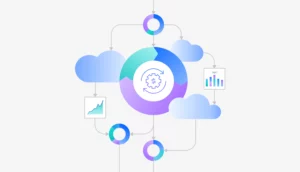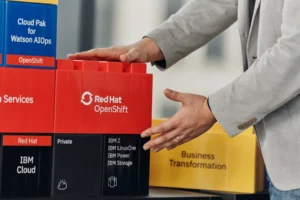
In 2023, organizations have faced an unprecedented level of pressure to digitally transform with the rise of generative AI as well as imperatives such as sustainability, labor productivity and security. The “Cloud Transformation Report,” a new global survey from the IBM Institute for Business Value (IBV), found that many leading enterprises share a common foundation to digital transformation—a clear hybrid cloud strategy.¹ These businesses cite several key benefits to using a hybrid cloud approach to fuel business transformation, including modernization, agility, security, sustainability and the ability unlock the power of generative AI.
Here’s a look at the key drivers that impacted cloud transformation over the past year and what they mean for companies on their cloud modernization journey:
Considerations for adopting generative AI
This year, generative AI captured the attention of business leaders—but it also raised questions including what’s the right foundation to accelerate and scale impact? For many organizations, the answer is a hybrid cloud approach. The new study found that 68% of hybrid cloud adopters have already established formal, organization-wide policies to direct their approach to generative AI.
With the rise of generative AI comes an influx of data. While this can fuel tremendous business innovations, it also requires strategic considerations. When executing an AI strategy, enterprises need to consider their current compute capacity, where data resides—in the cloud, on premises, at the edge—how data is accessed, necessary security controls, and how to use existing technology investments effectively. In addition to helping deliver enhanced reliability and performance, a hybrid cloud approach can enable increased agility with the ability to connect cloud and on-premises environments, removing barriers to flexible AI workflows.
Addressing security and compliance concerns
When it comes to generative AI, enterprises are also concerned about the potential exposure of sensitive data. For example, 45% of cloud leaders cited concerns about cybersecurity or privacy and confidentiality of data and information as the key obstacle in their push to implement generative AI. The findings indicate that highly regulated industries are increasingly weighing risks, such as security, when considering the technology. These organizations are less likely to have a formal approach to AI than some other industries, but they are showing progress: 57% of banks and financial markets organizations, 54% of insurers and 54% of life sciences/pharma institutions have adopted a formal approach to the technology so far.
For highly regulated industries that are tasked with safeguarding critical data, there’s a lot on the line. To avoid blind spots, a holistic security strategy that provides visibility across an entire hybrid cloud infrastructure is vital to mitigate risk.
Overcoming skills challenges
The report also shows persistent obstacles to more widespread cloud adoption — perhaps none as great as the ongoing skills gap. For example, 58% of global decision makers say that cloud skills remain a considerable challenge and 72% of organizations have created new positions to fulfill the need for cloud skills. Within individual industries, this deficiency is even greater: 79% in highly regulated industries such as banking and financial markets, as well as 81% in transportation and travel, and 79% in chemicals and petroleum.
Putting sustainability initiatives in the spotlight
Recently, sustainability has been tied to broader business goals and become a larger priority for technology investments for organizations across industries. Yet as generative AI grows, the increase in data processing required for AI workloads does too. This can present new challenges for organizations that are looking to reduce their greenhouse gas (GHG) emissions.
With the right tools in place, cloud can help enterprises track, manage and report on sustainability goals — including for partners and third parties. In fact, our findings determined that 42% of global decision makers confirm they are already using the cloud to help deploy, track and manage sustainability goals internally.
Looking to the future
With more enterprises embarking on their AI journeys, it will become critical for these organizations to ensure they have the right infrastructure and talent in place to support these initiatives. Organizations that shift to an agile, secure data structure with a hybrid cloud architecture will likely be the winners of tomorrow — armed with a strong foundation from which to compete in the future AI-driven landscape.
View the full IBM Institute for Business Value findings. Interested in getting started on your transformation journey? Here are some resources:
[1] This study was conducted in partnership with Harris Poll, an independent research firm.
More from Cloud

November 21, 2023
Level up your Kafka applications with schemas
4 min read – Apache Kafka is a well-known open-source event store and stream processing platform and has grown to become the de facto standard for data streaming. In this article, developer Michael Burgess provides an insight into the concept of schemas and schema management as a way to add value to your event-driven applications on the fully managed Kafka service, IBM Event Streams on IBM Cloud®. What is a schema? A schema describes the structure of data. For example: A simple Java class…

November 20, 2023
SSD vs. NVMe: What’s the difference?
7 min read – Recent technological advancements in data storage have prompted businesses and consumers to move away from traditional hard disk drives (HDDs) towards faster, lower-latency solid-state drive (SSD) technology. In this post, we’re going to look at this new technology, as well as the fastest and most popular protocol available to connect it to a computer’s motherboard—non-volatile memory express (NVMe). While the terms SSD and NVMe are often used to describe two different types of drives, they are actually different data storage…

November 14, 2023
An introduction to Wazi as a Service
4 min read – In today’s hyper-competitive digital landscape, the rapid development of new digital services is essential for staying ahead of the curve. However, many organizations face significant challenges when it comes to integrating their core systems, including Mainframe applications, with modern technologies. This integration is crucial for modernizing core enterprise applications on hybrid cloud platforms. Shockingly, a staggering 33% of developers lack the necessary skills or resources, hindering their productivity in delivering products and services. Moreover, 36% of developers struggle with the…

November 13, 2023
Top 6 Kubernetes use cases
5 min read – Kubernetes, the world’s most popular open-source container orchestration platform, is considered a major milestone in the history of cloud-native technologies. Developed internally at Google and released to the public in 2014, Kubernetes has enabled organizations to move away from traditional IT infrastructure and toward the automation of operational tasks tied to the deployment, scaling and managing of containerized applications (or microservices). While Kubernetes has become the de facto standard for container management, many companies also use the technology for a…
IBM Newsletters
Get our newsletters and topic updates that deliver the latest thought leadership and insights on emerging trends.
Subscribe now
More newsletters
- SEO Powered Content & PR Distribution. Get Amplified Today.
- PlatoData.Network Vertical Generative Ai. Empower Yourself. Access Here.
- PlatoAiStream. Web3 Intelligence. Knowledge Amplified. Access Here.
- PlatoESG. Carbon, CleanTech, Energy, Environment, Solar, Waste Management. Access Here.
- PlatoHealth. Biotech and Clinical Trials Intelligence. Access Here.
- Source: https://www.ibm.com/blog/business-leaders-highlight-the-need-for-a-hybrid-cloud-approach-to-unlock-the-power-of-generative-ai/
- :has
- :is
- :where
- $UP
- 1
- 13
- 14
- 20
- 2014
- 2023
- 28
- 29
- 30
- 300
- 31
- 39
- 40
- 400
- 7
- 9
- a
- ability
- About
- accelerate
- accessed
- across
- actually
- add
- addition
- adopted
- adopters
- Adopting
- Adoption
- advancements
- Advertising
- agile
- ahead
- AI
- AI strategy
- All
- already
- also
- amp
- an
- analytics
- and
- answer
- applications
- approach
- architecture
- ARE
- armed
- article
- AS
- At
- attention
- author
- Automation
- available
- avoid
- away
- back
- Banking
- Banks
- barriers
- BE
- become
- been
- benefits
- blind
- Blog
- blogs
- Blue
- broader
- business
- Business Leaders
- Business Transformation
- businesses
- but
- button
- by
- camera
- CAN
- Capacity
- captured
- carbon
- card
- Cards
- cases
- CAT
- Category
- challenge
- challenges
- check
- chemicals
- circles
- CIS
- cited
- class
- clear
- Cloud
- cloud adoption
- cloud infrastructure
- color
- comes
- Common
- Companies
- compete
- compliance
- Compute
- computer
- concept
- concerned
- Concerns
- conducted
- confidentiality
- Confirm
- Connect
- Consider
- considerable
- considerations
- considered
- considering
- Consumers
- Container
- continue
- controls
- Core
- created
- critical
- crucial
- CSS
- Current
- curve
- custom
- Cybersecurity
- data
- data processing
- data storage
- Date
- decision
- Default
- definitions
- deliver
- delivering
- deploy
- deployment
- describe
- description
- desk
- determined
- developed
- Developer
- developers
- Development
- difference
- different
- digital
- digital services
- digitally
- direct
- does
- drive
- drivers
- drives
- effectively
- emerging
- Emissions
- enable
- enabled
- engineer
- enhanced
- enjoy
- ensure
- Enter
- Enterprise
- enterprises
- Entire
- environments
- essential
- established
- Ether (ETH)
- Even
- Event
- example
- executing
- existing
- Exit
- explore
- exponential
- Exposure
- express
- Face
- faced
- fact
- false
- far
- faster
- fastest
- financial
- findings
- Firm
- flexible
- follow
- fonts
- For
- formal
- found
- Foundation
- from
- Fuel
- Fulfill
- full
- fully
- future
- gap
- GAS
- generative
- Generative AI
- generator
- get
- getting
- GHG
- glasses
- Global
- Goals
- going
- great
- greater
- greenhouse gas
- Grid
- grown
- Grows
- Hard
- Have
- Heading
- height
- help
- helping
- here
- Highlight
- highly
- history
- holistic
- Home
- How
- How To
- However
- HTTPS
- Hybrid
- hybrid cloud
- IBM
- IBM Cloud
- ICO
- ICON
- image
- Impact
- impacted
- implement
- in
- Including
- Increase
- increased
- increasingly
- independent
- index
- indicate
- individual
- industries
- industry
- influx
- information
- Infrastructure
- initiatives
- innovations
- insight
- insights
- Institute
- institutions
- insurers
- Integrating
- integration
- interested
- internally
- into
- Introduction
- Investments
- IT
- IT Support
- Java
- journey
- Journeys
- jpg
- kafka
- Key
- Kubernetes
- labor
- Lack
- landscape
- large
- larger
- latest
- leader
- leaders
- Leadership
- leading
- less
- Level
- Life
- likely
- Line
- local
- locale
- Look
- looking
- Lot
- major
- Makers
- manage
- managed
- management
- managing
- many
- Markets
- max-width
- mean
- Memory
- Michael
- microservices
- milestone
- min
- minutes
- Mitigate
- Mobile
- Modern
- modern technologies
- modernization
- modernizing
- more
- Moreover
- most
- Most Popular
- move
- Navigation
- necessary
- Need
- New
- Newsletters
- night
- None
- nothing
- November
- now
- obstacle
- obstacles
- of
- off
- offering
- Office
- often
- on
- ongoing
- open source
- operational
- optimized
- or
- orchestration
- organizations
- Other
- our
- over
- page
- parties
- partner
- partners
- Partnership
- past
- People
- performance
- perhaps
- person
- Petroleum
- PHP
- Place
- platform
- Platforms
- plato
- Plato Data Intelligence
- PlatoData
- plugin
- policies
- policy
- poll
- Popular
- portrait
- position
- positions
- Post
- potential
- power
- present
- pressure
- primary
- priority
- privacy
- processing
- Product
- productivity
- Products
- Products and Services
- Programmer
- Progress
- protocol
- provides
- public
- Push
- Questions
- raised
- rapid
- Reading
- reduce
- regulated
- regulated industries
- released
- reliability
- remain
- removing
- report
- required
- requires
- research
- Resources
- responsive
- right
- Rise
- Risk
- risks
- robots
- s
- safeguarding
- say
- Scale
- scaling
- Screen
- scripts
- secure
- security
- sensitive
- seo
- service
- Services
- several
- Share
- shift
- showing
- Shows
- significant
- Simple
- site
- skills
- skills gap
- So
- so Far
- Software
- Software Engineer
- some
- Sponsored
- spots
- squares
- staggering
- standard
- start
- started
- staying
- storage
- store
- Strategic
- Strategy
- stream
- streaming
- streams
- strong
- structure
- Struggle
- Study
- subscribe
- such
- support
- Survey
- Sustainability
- SVG
- Systems
- Talent
- tasks
- tech
- technological
- Technologies
- Technology
- terms
- tertiary
- than
- that
- The
- The Future
- their
- theme
- These
- they
- Third
- third parties
- this
- thought
- thought leadership
- Tied
- time
- Title
- to
- today
- tomorrow
- too
- tools
- top
- topic
- toward
- towards
- track
- traditional
- Transform
- Transformation
- transportation
- travel
- tremendous
- Trends
- two
- type
- types
- unlock
- unprecedented
- Updates
- URL
- use
- used
- using
- value
- visibility
- vital
- vs
- W
- was
- Way..
- weighing
- WELL
- well-known
- What
- What is
- when
- which
- while
- widespread
- will
- winners
- with
- within
- WordPress
- workflows
- working
- world’s
- written
- year
- yet
- young
- Your
- zephyrnet












